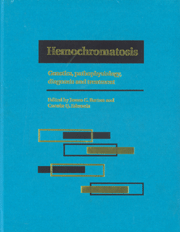Book contents
- Frontmatter
- Contents
- List of contributors
- Foreword
- Part I Introduction to hemochromatosis
- Part II Genetics of hemochromatosis
- Part III Metal absorption and metabolism in hemochromatosis
- Part IV Diagnostic techniques for iron overload
- Part V Complications of iron overload
- Part VI Therapy of hemochromatosis and iron overload
- Part VII Infections and immunity in hemochromatosis
- Part VIII Hemochromatosis heterozygotes
- Part IX Relationship of hemochromatosis to other disorders
- 42 Thalassemias and their interactions with hemochromatosis
- 43 Iron overload in sideroblastic and other nonthalassemic anemias
- 44 Hemochromatosis, iron overload, and porphyria cutanea tarda
- 45 Interactions of alcohol, iron and hemochromatosis
- 46 Iron overload in African Americans
- Part X Animal models of hemochromatosis and iron overload
- Part XI Screening for hemochromatosis
- Part XII Hemochromatosis: societal and ethical issues
- Part XIII Final issues
- Index
46 - Iron overload in African Americans
from Part IX - Relationship of hemochromatosis to other disorders
Published online by Cambridge University Press: 05 August 2011
- Frontmatter
- Contents
- List of contributors
- Foreword
- Part I Introduction to hemochromatosis
- Part II Genetics of hemochromatosis
- Part III Metal absorption and metabolism in hemochromatosis
- Part IV Diagnostic techniques for iron overload
- Part V Complications of iron overload
- Part VI Therapy of hemochromatosis and iron overload
- Part VII Infections and immunity in hemochromatosis
- Part VIII Hemochromatosis heterozygotes
- Part IX Relationship of hemochromatosis to other disorders
- 42 Thalassemias and their interactions with hemochromatosis
- 43 Iron overload in sideroblastic and other nonthalassemic anemias
- 44 Hemochromatosis, iron overload, and porphyria cutanea tarda
- 45 Interactions of alcohol, iron and hemochromatosis
- 46 Iron overload in African Americans
- Part X Animal models of hemochromatosis and iron overload
- Part XI Screening for hemochromatosis
- Part XII Hemochromatosis: societal and ethical issues
- Part XIII Final issues
- Index
Summary
Introduction
Primary iron overload is a problem among African Americans, but the condition is not often recognized by clinicians. The prevalence is not known, and whether a genetic defect is responsible is uncertain. In contrast, hereditary iron overload in the form of HLA-linked hemochromatosis is a well-recognized condition among whites in the United States, and a mutation in the newly described HFE gene on chromosome 6 is responsible for most cases. Several explanations for primary iron overload in African Americans are possible: (i) an admixture of the genetic defect for HLA-linked hemochromatosis from the Caucasian population of northern European extraction into the African–American population via interracial mating; (ii) a distinct but unidentified inherited defect that may be implicated in iron overload in Africa; and (iii) a sporadic occurrence of iron overload due to unidentified mechanisms. The HFE defect is rare in the African–American population and has not been identified in most African Americans with iron overload investigated. These observations suggest the possibility that primary iron overload in African Americans may be related to the iron-loading disorder found in the people of sub-Saharan Africa. Iron overload is a common condition in Africa where, in many areas, the prevalence of excessive body iron of a severity to cause damage to the liver is 10% or more.
- Type
- Chapter
- Information
- HemochromatosisGenetics, Pathophysiology, Diagnosis and Treatment, pp. 475 - 484Publisher: Cambridge University PressPrint publication year: 2000
- 4
- Cited by



